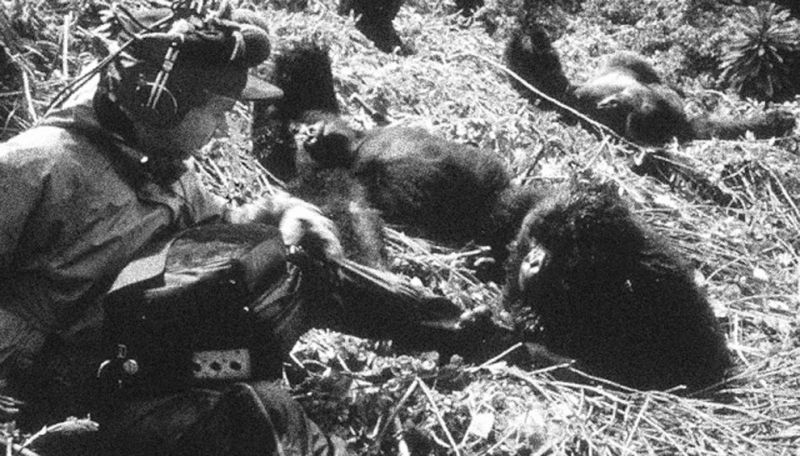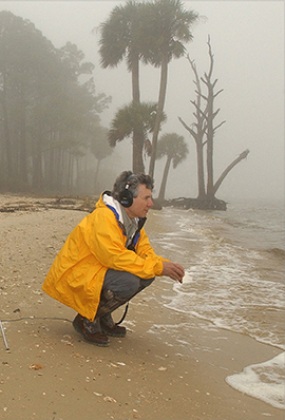Orchestra of the Wild
--by Bernie Krauss, syndicated from globalonenessproject.org, Jul 26, 2013
In a Sand County Almanac essay called The Great Gavilan, Aldo Leopold wrote:
There are men charged with the duty of examining the construction of the plants, animals, and soils which are the instruments of the great orchestra. These men are called professors. Each selects one instrument and spends his life taking it apart and describing its strings and sounding boards. This process of dismemberment is called research. The place for dismemberment is called a university.
A professor may pluck the strings of his own instrument, but never that of another, and if he listens for music he must never admit it to his fellows or to his students. For all are restrained by an ironbound taboo which decrees that the construction of instruments is the domain of science, while the detection of harmony is the domain of poets.
During my transition from a career in music to field recording in 1968, I searched everywhere for any description, written or otherwise, that would offer insights into the technical and bioacoustic particulars of my chosen craft and the methodologies used to evaluate the data. There were none. Having spent my entire musical life enclosed in well-insulated recording studios or concert halls, I knew of no contemporaries who had ventured into the natural world with a microphone and recorder. I was drawn to the more alluring scope of natural sound. There wasn't a single experienced or knowledge-able audio technician on whom I could rely. The only folks recording in the wild at that time were a few ornithologists collecting bird songs and calls and a few specialists in the field of naval marine warfare; they were capturing and studying the signatures of whales and fish, attempting the nearly impossible job of matching their acoustic expressions against the ominous sounds of ever-lurking Soviet submarines.
There was a larger problem. Since the protocols for field recording were limited primarily to a few general types of organisms, the models were restricted to the fragmented capture of individual species within those families. Only Leopold's observation - a lone voice that came from the light of profound understanding - suggested a portal into other possibilities. Leopold had inferred a wider, holistic bioacoustic scope twenty odd years before I ever set foot into a truly wild habitat.
My first opportunity to record in a natural biome took place almost half a century ago during the fall at Muir Woods, an old-growth coastal redwoods island habitat, small and intensely managed, just north of San Francisco's Golden Gate Bridge. My acoustic sensibilities were transformed by the space that enveloped me. The muted ambience heard throughout the woods, a constant reassuring whisper, came from a soft breeze in the upper reaches of the forest.
Listen: Midsummer Nights - West: Bullfrogs and a great-horned owl sing solo against the rhythmic pulse of the insect chorus in the Cascade Mountains of Northern California.
Few birds were singing. Most had long since fledged and migrated south for the winter. For equipment, Luis Baptista, a well-known ornithologist I met through the California Academy of Sciences, suggested using a single monaural microphone mounted to an ungainly parabolic dish. The dish was 36 inches in diameter, made of rigid plastic, and a fairly heavy Swiss-made monaural recorder - the only technology with which he was familiar. When I tried Baptista's system in Golden Gate Park later that summer - aside from being heavy and awkward to handle - the recorded result sounded small, compressed, noisy, and unnervingly artificial. It certainly was not the robust impression I had become familiar with in more controlled music studio environments. Luckily, my music partner, Paul Beaver, had a small and much lighter Uher reel-to-reel analog tape recorder and a pair of studio quality stereo mics. The mics were mounted on a jury-rigged, shock-absorbing contraption designed to minimize the vibrations transmitted from my hands to its pistol-like grip. I desperately wanted to record in stereo - the latest trend. The album we were commissioned to do for Warner Brothers, titled In a Wild Sanctuary, would become the first musical compilation based on the theme of ecology. It would be the first to include natural soundscapes as an integrated component of orchestration.
Before we committed the first note to our musical score, we needed to capture some examples of natural sound. A few birds flew overhead through the stereo space - right to left - the slow cadenced edge-tones of their undulating wings a diaphanous mix of whirr and shush. With my portable recording system, I didn't feel like I was listening as a distant observer; rather, I had been sucked into a new space - becoming an integral part of the experience itself. It was one of those moments you run toward and fully embrace with an open spirit, afraid it might not last. It was a step that would ultimately transform the ways in which I experienced the sounds of the natural world for the balance of my life.
Listen: Rainstorm in Borneo: Sensational claps of thunder and the rush of sudden rain provide an exciting sound sculpture of a thrilling, and comforting, storm in the South East Asian rain forests of Borneo.
Baptista had come from a long tradition of field recordists stretching back almost 70 years, one that began with the German ornithologist Ludwig Koch. In 1889, at eight years old, he isolated and recorded the first known animal voice, a bird called the common shama, onto a wax cylinder. He, in turn, was the beneficiary of an even older natural history tradition - the idea of abstracting single creatures out of their contextual existence in order to study them more closely. By the time he recorded his pet shama, this incoherent research paradigm for animal physiology and behavior and its separation from natural world context had become almost universal. This well-intended model had begun in earnest in the late 18th century with Linnaeus' classifications and continued into the present. Koch's efforts served as the inspiration for nearly all of the sound fragmentation work that followed.
In the spring of 1935, a team of birders, including Arthur Allen and Peter Paul Kellogg from the Cornell University Lab of Ornithology, and a few other colleagues, entered a gater-infested Georgia fen. After discovering that they could isolate the sound of a single bird by using what ornithologists of the 1920s called a sound mirror—an early version of the parabolic dish—and recording the signal to the optical track of a Movietone sound recorder originally designed for film, they decided to chase down and record the rare ivory-billed woodpecker. This team of birders was on a mission, mounted on a mule-drawn wagon loaded with hundreds of pounds of recording gear. After the bird and its nest were finally spotted, the researchers captured one clear recording of the likely now-extinct creature. Nearly every bird recording mission after that moment was focused on the capture of single species voices with almost no thought given to the ways in which those signatures might fit into the larger bioacoustic spectrum from which they had sprung.
Listen: African Safari - Zimbabwe: This recording offers proof that some vocal animals use their habitats as a performance hall in which to render their operas in harmony with other creatures. At the beginning, hear the baboons echo their voices off the rocks.
Nearly eight decades later, the decontextualized, single-species model these scientists established ushered in a narrow academic recording format, which is still favored by many. Based on the idea of life lists -- finding and identifying single species of birds and mammals and, more recently, amphibians and insects--the approach of collecting isolated animal sounds by the numbers became firmly entrenched. This continues to be expressed in some of the world's largest collections of sound such as the Macaulay Library of Natural Sound at Cornell University, and the British Library of Wildlife Sounds located in London. To me, however, this narrow focus always seemed like the equivalent of trying to understand the magnificence of Beethoven's Fifth Symphony by abstracting the sound of a single violin player out of the context of the orchestra, hearing just that one part.
Focus on the capture of single sound examples initially forced me--and everyone else, from casual listeners to serious researchers--to confine our early inquiries to the limits of each vocalization, whatever its origin. But for humans, especially, the sound-fragmentation model distorts a sense of what is wild by giving us an incomplete perspective of the living landscape. The result is that a necessary link between the human and nonhuman aural worlds is essentially ignored.
The soundscape is invaluable as a window into ecological and musical literacy. This first became obvious to me while I was recording in the equatorial forests of Africa, Latin America, and Asia. I was bored with chasing individual species and hearing single-channel monaural playbacks. The music producer training in me surfaced and I'd set up a pair of stereo microphones and hunkered down. As night fell, I felt enchanted and blessed to be enveloped in a world of 3-D sound. A deliverance from the monotonous single-track recordings of older models, the sound was more illuminating and evocative of a place than was any photograph. The captured ambiences—rich textures that infused the entire frequency spectrum with elegant structure inclusive of multiple tempi, melodies, and filled with dazzling soloists and choruses, alike—intensified my experience of the habitat through their vibrant nuances generated as points of sound transported through the acoustic space.
But that realization, alone, was simply not enough. We needed to define and measure the broader soundscape in terms that addressed its three fundamental sources to this concept. The three terms are: the geophony, the biophony, and the anthrophony. The geophony were the first sounds on earth, the natural sounds: wind, water, earth movement, and rain; it is a source of beauty and complexity and deserves to be explored on its own terms. The word biophony comes from the Greek prefix bio, which means "life" and the Greek suffix phon, which means "sound." Biophony: the sounds of living organisms. Anthrophony includes includes all of the sounds we humans produce.
Listen: Amazon Days, Amazon Nights: Night sound sculptures from the heart of the Amazon rain forest. Monkeys, jaguars, birds and musical frogs spring to life.
With clear terminology now in hand to describe these phenomena, it was equally important to have the ability to transform the data so that they are readable by other senses. One of these tools is a spectrogram - a graphic illustration of sound displaying both time and frequency across the entire spectrum of life. This tool clarifies the many ways in which biophonies are organized. The detail contained within spectrograms is quantifiable by organization, individual species' expression, and the relationships between them such as time and frequency. Initial resistance to and rejection of the concept had been based on the inability, unwillingness, or fundamental lack of curiosity to understand how the data could be used as a means of habitat evaluation across the broad scope of vocal organisms and the numerous disciplines it touched upon.
As my colleagues are aware, there are many facets to soundscapes that we haven't yet begun to explore. Ours, after all, is a youthful endeavor just a few decades old.

But from the ways in which our art and craft have evolved in the short period that Western scientists have explored the universe of Soundscape Ecology, it is now apparent that biophonies help clarify our understanding of the natural world.
From recorded analysis, we are now able to assess the impact of resource extraction, human noise, land transformation, pollution and global warming, among many other conditions. Where Soundscape Ecology has previously been limited almost exclusively to the measurement of organisms from the perspective of singular abstraction, a much fuller understanding can be realized from more holistic methods of observation.
Biophonies and geoph​onies are the signature voices of the natural world. And as we hear them we are endowed with a sense of place—the true story of the world we live in. In a matter of seconds, an acoustic snapshot of biophonies reveals more information from many aspects, from quantifiable data to cultural inspiration. While a picture may be worth a thousand words, a soundscape is worth a thousand pictures. Our ears tell us that the whisper of every leaf and creature speaks to the natural sources of our lives, which, indeed, may hold secrets of love for all things, especially our own humanity.
To explore the sounds recorded by Bernie Krause, visit Wild Sanctuary.
Bernie Krause, known as the father of soundscape ecology, describes how he came to record the voice of the natural world. This article originally appeared in The Global Oneness Project -- a digital, ad-free, bi-monthly magazine. Through stories, The Global Oneness Project explores the threads that connect culture, ecology, and beauty. Our collection of films, photography, and essays feature diverse and dynamic voices from around the world.








